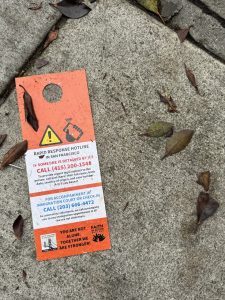President Donald Trump’s Oct. 23 decision to cancel a planned surge of federal immigration agents into San Francisco has failed to quell anxiety in the Bay Area about detainment and deportation of undocumented immigrants.
“We do not see this as anything other than a pause for the moment,” said Susan Austin, co-lead of Indivisible Mid-Peninsula, a regional arm of the national Indivisible group.
Calls continue for local activists to mobilize at street corners to protect day laborers who fear sudden detainment at Home Depots and other locations and local groups are sending witnesses to accompany undocumented people to mandatory court check-in appointments.

“We have seen a tremendous amount of fear amongst the community that we serve…this overwhelming, sometimes paralyzing, fear that there might be ICE activity in our community,” said Efrain Barrera, interim executive director of Mission Language and Vocational School in San Francisco.
“We don’t know what tomorrow might bring,” Barrera added. “Policies can change with the flip of a pen and so we are doing our due diligence, again, to keep our community safe regardless of what’s coming from the federal government.”
For the Mission District, a historic Latino neighborhood in San Francisco, this constant state of fear is especially true. Mission residents are scared to access community services. Know-your-rights flyers litter sidewalks and immigrant resource centers keep their doors locked throughout the day.
Gabriel Medina, executive director of La Raza Community Resource Center, estimated their center saw a 15% drop in use of their food pantry the week of Oct. 19. “It was certainly the most pronounced drop off of this 10-month administration,” Medina said.
On Monday Oct. 27, in a special hearing, Milli Atkinson, Director of the Immigrant Legal Defense Program also noted a long-term spike in use of the city’s legal defense hotline. In the three-month period between July and September, the hotline saw roughly 2,000 calls compared to the 1,200 calls the hotline typically receives in an entire year. Atkinson also noted that between May and early October, 87 people were arrested while attending their immigration hearings at the San Francisco Immigration Court.
Detentions continue. On Oct. 25, according to the San Francisco Chronicle, 25 undocumented immigrants were detained by ICE agents after receiving emergency immigration orders to report to the Stockton ICE office for weekend check-ins. “San Francisco may be spared for now [from a surge], but the reality is that the Bay Area is big and so any ICE enforcement is going to impact our community no matter what,” said Barrera.
For months, the Mission District and resource centers have been preparing for a surge, yet the most recent scare was a wakeup call. “This latest threat just made the threat much more tangible and real as to what could happen,” said Medina. “It made it feel closer than it’s ever been felt before.”

